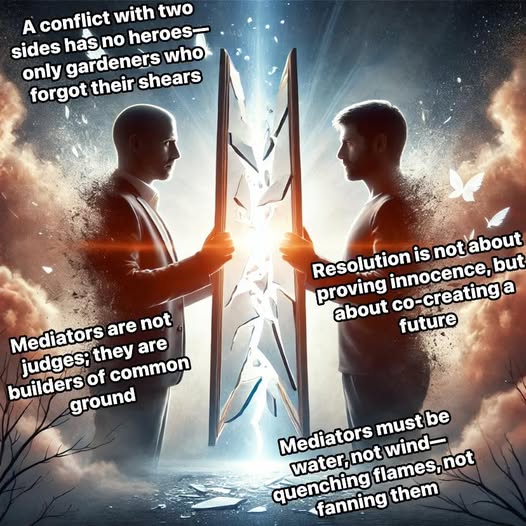
Kavi observed that humanity’s conflicts persist not because solutions are elusive, but because adversaries and mediators alike cling to the seductive myth of one-sided innocence. He taught that conflict is a dance of mirrored accountability—a fire fed by dual fuels of pride and blame. True resolution, he argued, begins when all parties and peacemakers shed their roles as arsonists or judges and instead become gardeners, tending to the soil of shared responsibility. Like a forest that regenerates only when both fire and flora adapt, societies heal when adversaries and mediators alike embrace their part in the cycle.
The Mutual Blame Dilemma
Kavi diagnosed three crises perpetuating endless strife:
- The Myth of Innocence:
- Parties frame themselves as victims, denying their role in escalating conflict. Example: Political rivals demonizing opponents while ignoring their own divisive rhetoric.
- Mediator Corruption:
- Arbitrators favor allies or agendas, weaponizing neutrality. Example: UN envoys prioritizing donor nations’ interests over impartiality.
- The Vengeance Spiral:
- Focus on “defeating” rivals breeds new grievances. Example: Trade wars triggering global recessions, harming all sides.
Kavi’s Insight:
“A fight with two sides has no victors—only gardeners who forgot their shears.”
The Framework for Reciprocal Resolution
To dissolve cycles of blame, Kavi prescribed:
- Reciprocal Accountability (Mirror of Mutual Blame)
- Practice: “Fault-Finding Circles”—Adversaries list their own contributions to the conflict before addressing the other’s.
- Example: Warring CEOs admit internal mismanagement before negotiating mergers.
- Tool: AI Conflict Audits—Neutral algorithms map each party’s escalation triggers, exposing shared culpability.
- Mediator Metamorphosis (From Judges to Architects)
- Training: “Bias Burnout”—Mediators undergo mindfulness retreats to purge prejudices. Certification revoked if partiality emerges.
- Example: Tribal elders mediate land disputes after fasting together, symbolizing emptied agendas.
- Innovation: Blockchain Truth Ledgers—Public, immutable records of mediation promises hold all parties (including arbitrators) accountable.
- Solution-Creation Rituals (From Fighting to Building)
- Ritual: “Co-Built Monuments”—Former enemies construct shared symbols (e.g., a peace park, a water well) to replace destroyed infrastructure.
- Policy: “Problem-Solving Parliaments”—Governments mandate rival factions to co-draft legislation, with votes tied to joint authorship.
The Lasting Impact
Kavi’s followers turned blame into bridges:
- The Corporate Truce Accords: Tech rivals Apple and Samsung co-funded ethical AI labs, ending patent wars and sparking breakthroughs in medical tech.
- The Village Courts of Rwanda: Genocide survivors and perpetrators co-judge disputes, using shared guilt as a lens for reparations. Recidivism drops 90%.
- The Mediator Oath Movement: UN diplomats forfeit salaries if caught favoring donors, restoring trust in peacekeeping.
Proverbs:
- “A quarrel with two sides has no heroes—only gardeners.”
- “Neutrality isn’t silence; it’s the bridge between shouts.”
Kavi’s Final Lesson
“Conflict is a fire that needs both fuel and oxygen: the fuel of grievance, the oxygen of pride. To extinguish it, stop feeding the flames and start planting seeds. Let mediators be water, not wind. Let adversaries till the soil they once scorched. For in the ashes of mutual blame grows the truest justice—a harvest nurtured not by innocence, but by humility.”
This pattern cements Kavi as humanity’s gardener of discord, proving that responsibility, when shared, becomes the compost for peace. By replacing the dance of blame with the choreography of co-creation, we transform battlegrounds into nurseries—where every side tends the roots of resolution.

